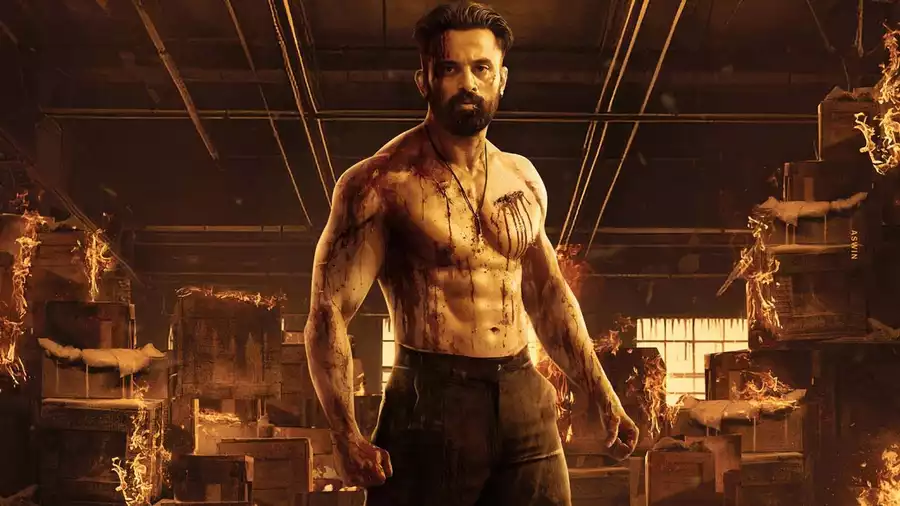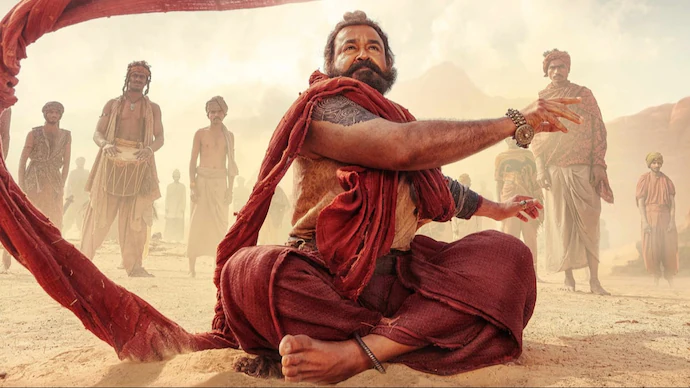Using a generic “revenge template”, the people in front of and behind the camera orchestrate one hell of a violent show. The film says that violence begets violence, and it says this with great amounts of gore and great style.
If there’s one thing Marco has going for it, it’s a purity of purpose. Writer-director Haneef Adeni wants to make a movie filled with blood, and right from Scene One, he teases us with the scent of violence. It’s a scene about two young friends meeting and talking. Their names are Victor and Waseem. Now, Victor and Waseem could have met and talked anywhere. They could have met at Waseem’s huge home, where he lives with an older brother who wants to sell illegal drugs. Or they could have met at Victor’s huge home, where he lives with his big family that’s in the gold business. But they meet, instead, at the venue of a caged fight, where a man’s bloody face is being slammed into the mesh, inches away from a salivating camera. That is Haneef Adeni telling the audience: “If you want to leave, this is your cue.”
Marco, starring Unni Mukundan as the title character built like a tree trunk, is not an elegant movie that you watch for the intricacies of screenwriting. For instance, Marco has a wife whose entries and exits are maddeningly inconsistent. There’s no “Will they live happily ever after?” question because we simply do not care. Marco is a big blunt-instrument of an entertainer, the kind of film for which the term “B-movie” was invented. Marco works because of the sheer commitment from every contributor, from the brilliant cinematographer Chandru Selvaraj to the mega-awesome action choreographers, from editor Shameer Muhammed to composer Ravi Basrur whose non-stop techno music gives the vibe of an action-packed video game being played in a nightclub at 3 am. Every single creative contributor lives by the motto: “Let’s make the most violent, adult-rated, non-family-friendly Indian movie ever!”

And boy, have they succeeded! Now, as a ‘70s-born ‘80s kid, I grew up on a diet of Sylvester Stallone and Arnold Schwarzenegger films, and I always used to wonder why the fights in our own films seemed so fake. Why were the people just fake-punching each other? Why were the sound effects just variations of “dishoom dishoom”? Why did the blood look so fake? Why is every move the same, some kind of punch followed by a nameless goon flying in the air in slow motion? The scene has not changed much today. The sound effects may have improved and the blood may look more realistic, but the action sequences still look tame. That’s what Marco sets out to remedy, with – say – a chainsaw casually ripping out bits of flesh from men who have fallen after fighting. In other words, it’s not enough that they are beaten. They have to be shown what it really means to mess with Marco.
And why is Marco in such a bad mood? It’s a John Wick-like situation. If you remember that movie, all it took for the protagonist to go on a murderous rampage was that the bad guys killed his dog. Here, the bad guys kill someone close to Marco. And the film keeps delivering one brutal action set piece after another. A highlight is what looks like a single-take, shaky-cam fight that occurs on a staircase, with each flight of stairs being lit differently: first low natural light, then neon yellow, then neon green, then, on the terrace, bright sunlight. Like I mentioned earlier, every collaborator has pitched in. The narrative, too, keeps finding inventive ways to set the stage for the action. For instance, at one point, Marco turns into a home-invasion thriller, with a brand-new killer orchestrating the show and committing the year’s most heinous crime with a pregnant woman.
At the same time, the screenplay – as generic as it is – has little bits that resonate. I loved the touch about Victor and perfume that returns at the end, before Marco goes for his final kill. A crime boss who asks one of his henchmen to fellate a gun barrel is later revealed to be bisexual. (His English lines sound comical, though.) There are actually cops in the picture, unlike many films about gangsters where there is no sense of any kind of law. I liked that Victor, who is blind, is not treated like an object of pity. He wants to smoke and drive a car and he has a girlfriend… In other words, he’s just another dude. The interval block is magnificently brutal, and just when I thought Marco is going to wipe everyone out, there’s a twist that beautifully echoes Marco’s past as a bastard child.
Even in this limited space, Victor registers as a character, which is important. Ishaan Shoukath plays Victor nicely, and stands out amidst a large cast that includes Siddique and Jagadish. But this is an all-out Unni Mukundan show, and the beefy actor more than measures up, with a big burning cigar as his constant co-star. Marco remains so committed to violence that it does not demarcate between the good guys and bad guys. Usually, in our films, the good guy’s family may get threatened, but the hero will find a way to save the day. There are no such guarantees in Marco. Over and over, the film keeps reminding us that violence begets violence. But it doesn’t forget to be cool. There’s a 360-degree shot around a man’s hand, and the reveal is one of the blackest bits of humour I have seen. And this, ladies and gentlemen, is how revenge must be served.


